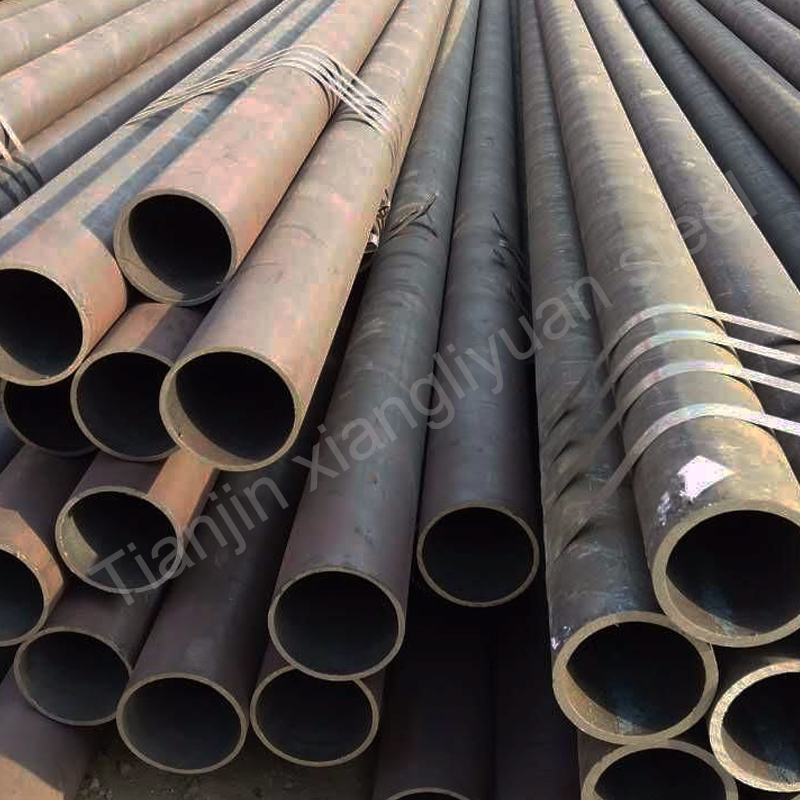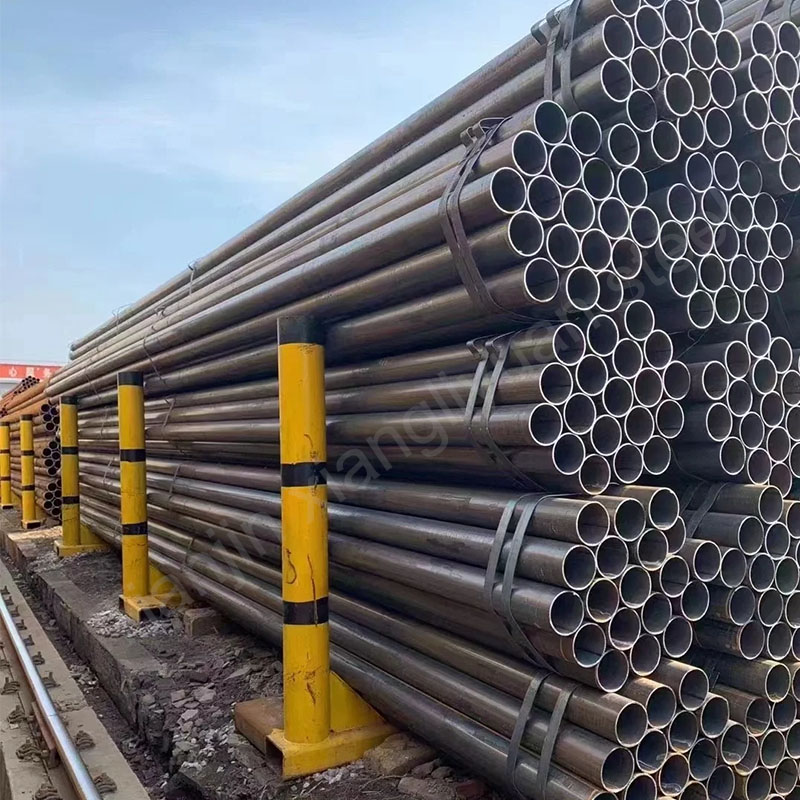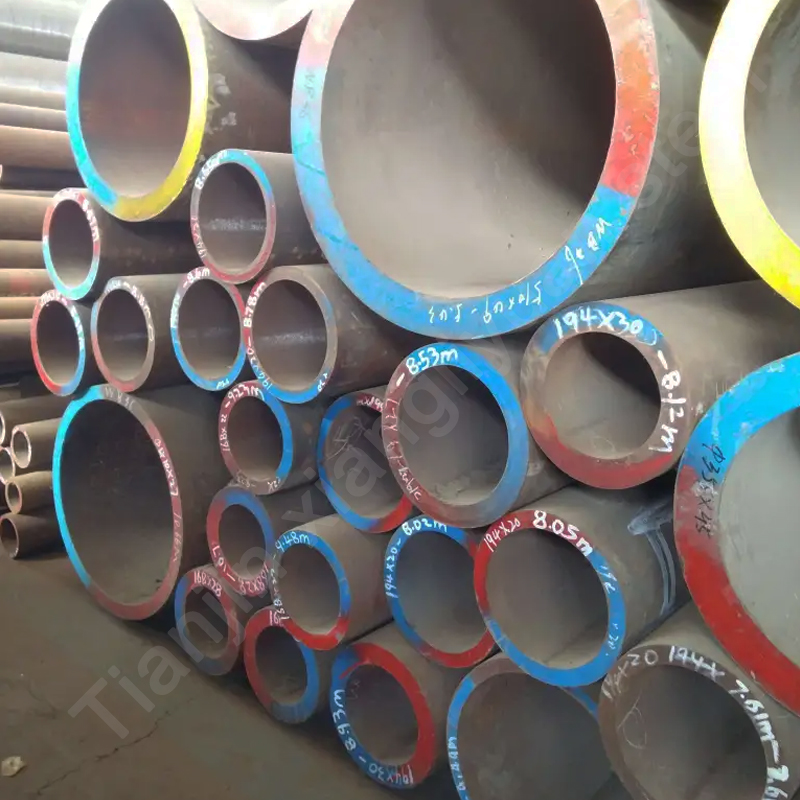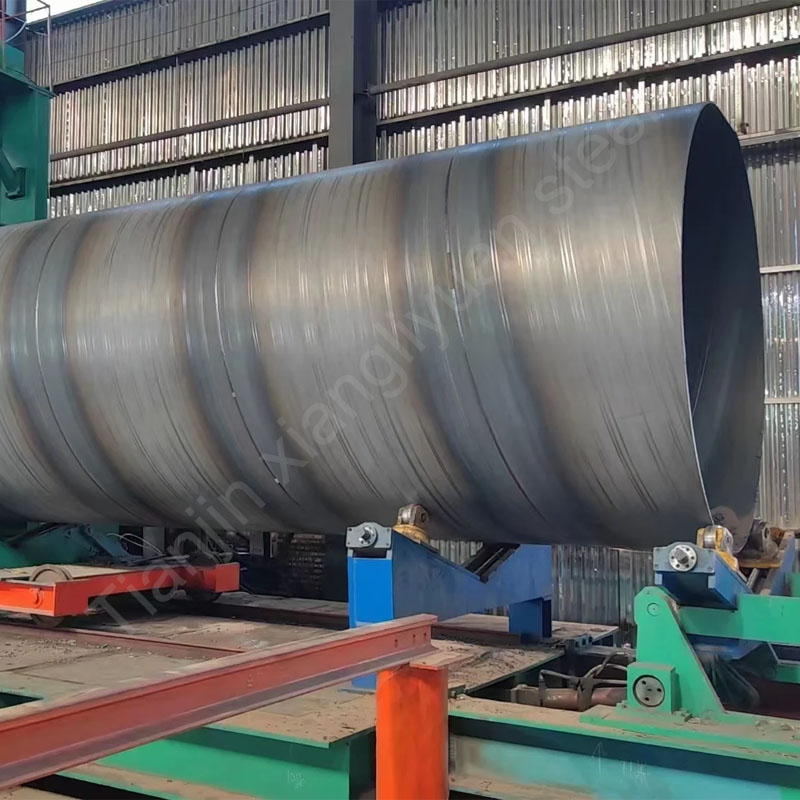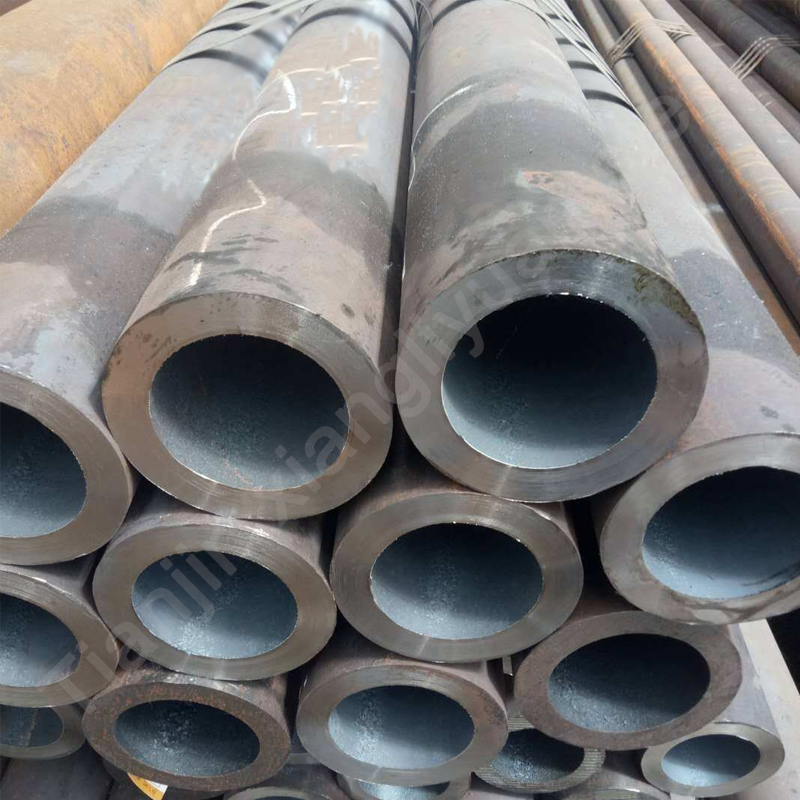Hot-rolled carbon steel pipe is a basic material widely used in construction, machinery manufacturing, petrochemical and other industries. It uses carbon steel as the main raw material and is formed by hot rolling process. It has good mechanical properties and processing characteristics and is suitable for making various pipe fittings and components.
Production process
The production process of hot-rolled carbon steel pipe mainly includes the following steps:
Material preparation: Select suitable carbon steel raw materials, such as medium-low carbon steel or medium-high carbon steel, and determine the steel type according to the specific requirements of the product.
Heating: Put the raw steel billet into the heating furnace for high-temperature heating, generally at a heating temperature of about 1200℃. Soften the steel billet at high temperature for the next forming process.
Piercing: The heated steel billet is pierced by a piercing machine to form a hollow tube billet.
Rolling: The pierced tube billet is rolled through a series of rolling mills for multiple times, and gradually formed into a steel pipe with the required wall thickness and diameter.
Cooling and sizing: After rolling, the pipe is cooled and sizing is performed by water cooling and other processes to ensure that the finished product size meets the requirements.
Cutting and shaping: Cut the sized steel pipe into the required length, and shape and treat the surface at the same time.
Inspection and packaging: Finally, conduct quality inspection to ensure that the product meets the standards before packaging and shipment.
Steel grade classification
The steel grade of hot-rolled carbon steel pipe is distinguished according to the carbon content and specific use of the steel, usually divided into low carbon steel, medium carbon steel and high carbon steel. The following are some common hot-rolled carbon steel pipe steel grades:
1. Low carbon steel (carbon content is 0.06%-0.25%)
Q195, Q215, Q235: This type of steel grade has a low carbon content, good plasticity and toughness, and is easy to weld and process. It is widely used in building structures and general engineering purposes, especially for occasions requiring cold processing.
Q275: Compared with Q235, Q275 has higher strength and is suitable for structural components with higher load-bearing capacity.
2. Medium carbon steel (carbon content is 0.25%-0.60%)
20#, 35#, 45#: These steel grades have a good balance of strength and hardness. 20# steel has good toughness and is suitable for manufacturing engineering structural parts with high requirements; 45# steel has higher hardness and strength and is often used in mechanical structures and parts manufacturing, such as bearings, gears, bolts, etc.
40Cr: It belongs to alloy structural steel, but it is widely used and is often used to manufacture mechanical parts with large forces, such as automobile shafts, bolts, etc.
3. High carbon steel (carbon content is above 0.60%)
60#, 65Mn: These steel grades have a high carbon content, significantly improved strength and hardness, but low toughness, and are suitable for manufacturing springs, knives and other occasions that require high hardness.
70#, 75#: They have higher hardness and wear resistance and are usually used to manufacture high-strength and high-wear-resistant parts.
4. Low alloy high strength steel
Q345: It is a low alloy high strength steel with higher strength and better impact resistance, as well as good weldability and corrosion resistance. It is suitable for structural parts with medium strength and toughness requirements, and is one of the commonly used steel grades in construction and engineering.
5. Commonly used steel grades in international standards
ASTM A106 Grade B: Carbon steel pipe steel grade commonly used in American standards, suitable for pipelines under high temperature and high pressure conditions, such as oil and natural gas transportation.
ST37, ST52 (DIN standard): Common steel grades in German standards, ST37 is ordinary carbon steel, suitable for general structural parts; ST52 is low alloy high strength steel, suitable for engineering and mechanical parts requiring higher strength.
Related standards
The production and application standards of hot rolled carbon steel pipes vary according to different countries and regions. The following are some common international and domestic standards:
1. Chinese standard
GB/T 8162 – “Seamless Steel Pipe for Structural Use”
Carbon steel pipes used for general structures and mechanical structures, including the manufacture of building frames, bridges and mechanical parts.
GB/T 8163 – Seamless steel pipe for conveying fluids
Applicable to carbon steel pipes for conveying fluids, such as water, oil, and gas pipelines.
GB/T 3087 – Seamless steel pipe for low and medium pressure boilers
Applicable to carbon steel pipelines in medium and low pressure boiler systems, with high heat resistance.
GB/T 5310 – Seamless steel pipe for high pressure boilers
Applicable to carbon steel pipelines for high and ultra-high pressure boilers and power stations, requiring excellent high temperature and high pressure performance.
GB/T 17396 – Hot-rolled seamless steel pipe for hydraulic props
Used in the production of hydraulic props, mainly used in coal mines and other supporting structures.
GB/T 6479 – Seamless steel pipe for high pressure fertilizer equipment
Applicable to high pressure seamless steel pipes used in fertilizer equipment, which must meet the requirements of use under high temperature and high pressure.
2. American Standard
ASTM A53 – Seamless and welded steel pipes for general use
Applicable to fluid conveying pipelines with low pressure, widely used in the transportation of water, gas, air, etc.
ASTM A106 – Seamless Carbon Steel Pipe for High Temperature Use
Used for piping systems in high temperature environments, such as high temperature transportation of oil and natural gas, requiring good high temperature resistance and pressure resistance.
ASTM A179 – Cold-drawn Low Carbon Steel Pipe for Heat Exchangers and Condensers
Mainly used in heat exchangers and condensers, requiring high surface accuracy and good corrosion resistance.
API 5L – Pipeline Steel Pipe
Used for pipeline transportation in the oil and gas industry, especially suitable for long-distance and high-pressure transmission pipelines.
3. Japanese Standard
JIS G3441 – Seamless Steel Pipe for Mechanical Structures
Applicable to structural parts of various mechanical equipment, including automotive parts, industrial machinery, etc.
JIS G3454 – Seamless Steel Pipe for Pressure Pipes
Applicable to carbon steel pipelines that withstand internal pressure, mainly used in fluid transportation systems.
JIS G3461 – Seamless Steel Pipe for Boilers and Heat Exchangers
Applicable to carbon steel pipeline systems in boilers and heat exchangers, requiring good heat resistance and corrosion resistance.
4. European Standards
EN 10210 – “Hot-formed hollow sections of non-alloy and fine-grained structural steels”
Applicable to hot-rolled hollow steel pipe fittings in structural engineering and construction.
EN 10216 – “Seamless steel pipes for pressure purposes”
Applicable to seamless steel pipes for high pressure, divided into different parts, for general use, high temperature and corrosion resistant environments.
EN 10255 – “Non-alloy steel pipes, suitable for welding and threading”
Mainly used for low-pressure fluid transportation, suitable for welding and threading occasions.
5. German Standards (DIN)
DIN 2448 – “Seamless steel pipes”
Seamless carbon steel pipes for a variety of applications, including mechanical structures, fluid transportation, pressure pipelines, etc.
DIN 1629 – “Seamless non-alloy steel pipes, suitable for fluid transportation”
Carbon steel pipes for non-high-pressure fluid transportation, usually used at room temperature.
6. International Standards
ISO 3183 – Line Pipe for Petroleum and Natural Gas Industry
The standard for global oil and gas pipelines covers the quality and safety requirements for long-distance pipelines.
ISO 9329-1 – Seamless Steel Pipes for Pressure Applications
Seamless steel pipes for pressure equipment, mainly used in high temperature and high pressure fields such as petrochemicals and boilers.
Features and Advantages of Hot-Rolled Carbon Steel Pipes
Hot-rolled carbon steel pipes have the following main features and advantages:
High strength and good mechanical properties: Due to the characteristics of the hot rolling process, the grains of carbon steel pipes become more uniform during processing, so they have higher strength and toughness.
Low cost: Compared with other alloy steel pipes, hot-rolled carbon steel pipes have lower raw material costs and more economical processing costs, so they are widely used in many engineering and industrial applications.
Good corrosion resistance and wear resistance: Through appropriate surface treatment and heat treatment, hot-rolled carbon steel pipes can have good corrosion resistance, especially in occasions where fluids are transported or in contact with water, acid and other media.
Easy to process and weld: Hot-rolled carbon steel pipes have good ductility, excellent processing and welding properties, so they are easy to use in the manufacture of various pipe fittings and structural parts.
Application fields
Hot-rolled carbon steel pipes are widely used in many industries:
Building structures: used for building frames, bridges, towers and other structural parts to provide support and stability.
Oil and gas: used as pipelines for oil and gas, capable of withstanding high pressure and temperature.
Machinery manufacturing: used to manufacture automotive parts, mechanical parts, such as bearing sleeves, transmission shafts, etc.
Chemical and energy: used as the main component of heat transfer pipes, heat exchangers and other equipment in the chemical and power industries for transmitting fluids.
Municipal engineering: used for tap water and sewage pipes, heating pipes, etc., with good economy and practicality.
As a high-strength, cost-effective basic material, hot-rolled carbon steel pipes have been widely used in many industries due to their excellent mechanical properties, good processing properties and low production costs. With the advancement of technology and the diversification of market demand, hot-rolled carbon steel pipes will continue to be improved to meet various industrial needs.

